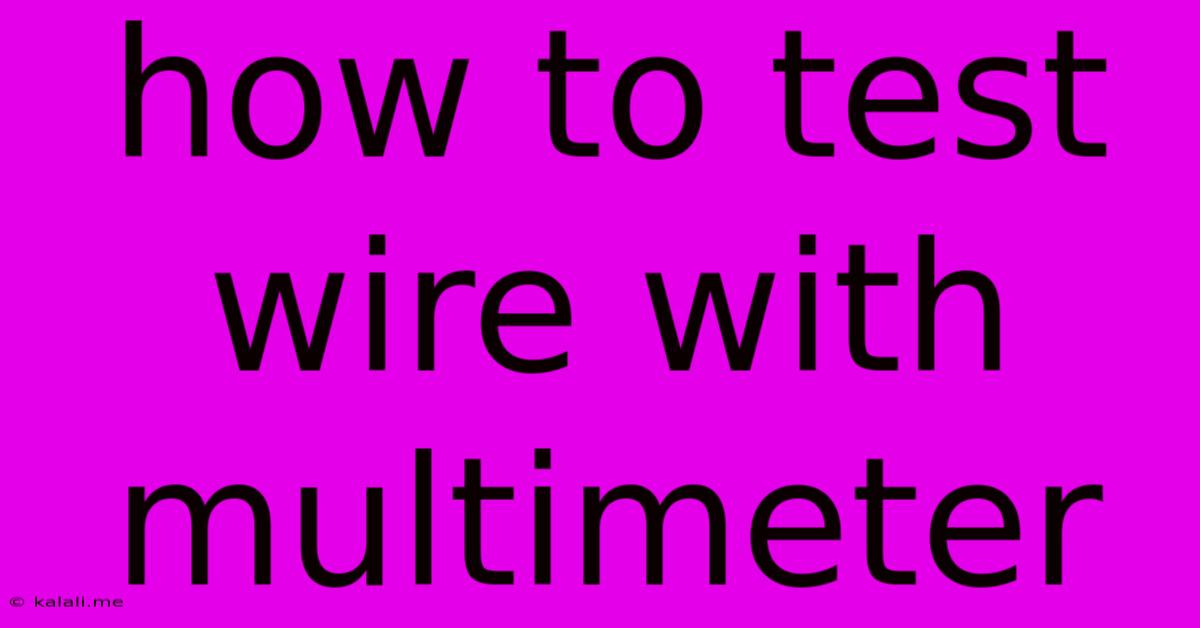How To Test Wire With Multimeter
Kalali
Jun 05, 2025 · 3 min read

Table of Contents
How to Test a Wire with a Multimeter: A Comprehensive Guide
Testing wires with a multimeter is a fundamental skill for electricians, DIY enthusiasts, and anyone working with electrical circuits. This guide will walk you through the process, covering different scenarios and troubleshooting common issues. Knowing how to properly test a wire can help ensure safety, prevent damage to equipment, and identify faulty wiring quickly and efficiently.
Understanding Your Multimeter and Wire Types
Before you begin, familiarize yourself with your multimeter's settings. Most multimeters have a continuity test mode (often symbolized by a diode or a continuity symbol), a resistance measurement mode (usually denoted by Ω), and a voltage measurement mode (V). Knowing how to switch between these modes is crucial.
You'll also need to understand the type of wire you're testing. Is it solid core, stranded wire, or something else? The type of wire doesn't directly affect the testing process, but understanding its construction can help you interpret the results.
Testing for Continuity (Checking for Breaks)
This is the most common test for wires. Continuity testing checks if there's a complete, unbroken path for electricity to flow through the wire.
-
Set your multimeter to the continuity mode. You should hear a beep or see a visual indication when continuity is detected.
-
Connect the multimeter probes to the ends of the wire. Ensure good contact between the probes and the wire. If the wire is part of a larger circuit, ensure the circuit is de-energized. Safety first!
-
Observe the reading. A continuous beep or visual indication signifies a good connection. No beep indicates a broken wire or a poor connection.
Troubleshooting Continuity Test Issues:
- No beep: This usually means a broken wire, a bad connection at a terminal, or a faulty multimeter. Try different sections of the wire.
- Intermittent beep: This could indicate a loose connection or a partially broken wire. Examine the wire carefully for damage.
Measuring Wire Resistance
This test measures the resistance of the wire, which can indicate its condition and length. Higher resistance generally indicates a longer wire or a wire with corrosion or damage.
-
Set your multimeter to the resistance mode (Ω). Select an appropriate range; start with a lower range and increase if necessary.
-
Connect the probes to the ends of the wire. Make sure the wire is disconnected from any power source.
-
Observe the reading. A low resistance value indicates a good wire. A high resistance value might indicate a damaged or corroded wire.
Interpreting Resistance Readings:
- Low Resistance: This is expected for short, undamaged wires. The exact value depends on the wire's length, gauge, and material.
- High Resistance: This could indicate a broken wire, corrosion, or a very long wire.
- Infinite Resistance (OL): This usually means an open circuit—no path for electricity to flow.
Testing for Voltage (Only for Energized Circuits - Use Extreme Caution!)
This test should only be done by experienced individuals with proper safety precautions. Testing voltage on a live wire can be dangerous. Always ensure the circuit is de-energized before performing any other tests.
-
Set your multimeter to the appropriate voltage range (AC or DC). Select a range higher than the expected voltage.
-
Carefully touch the probes to the wire. Ensure that your body is not touching any other parts of the circuit.
-
Observe the reading. A reading indicates voltage present in the wire. No reading indicates that the wire isn't carrying voltage (or there's a problem with your connection).
Safety Precautions:
- Always disconnect the power source before testing wires.
- Use insulated probes and tools.
- Never touch exposed wires.
- If you're unsure, consult a qualified electrician.
By following these steps and understanding the readings, you can effectively test wires with a multimeter and identify potential problems. Remember to prioritize safety at all times when working with electricity.
Latest Posts
Latest Posts
-
Is Policy Changes A Noun Or Verb
Jun 06, 2025
-
Se Puede Deshacer El Rgb Outline En Illustrator
Jun 06, 2025
-
Reasons Cron Job Isnt Firing At A Given Time
Jun 06, 2025
-
Convert Latitude Longitude To State Plane Coordinates
Jun 06, 2025
-
Question Cheetah Find All The Stereocenters In
Jun 06, 2025
Related Post
Thank you for visiting our website which covers about How To Test Wire With Multimeter . We hope the information provided has been useful to you. Feel free to contact us if you have any questions or need further assistance. See you next time and don't miss to bookmark.